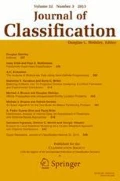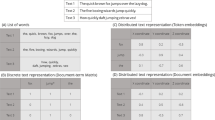Abstract
Rhetorical strategy is relevant in the law domain, where language is a vital instrument. Textual statistics have much to offer for uncovering such a strategy. We propose a methodology that starts from a non-structured text; first, the breakpoints are automatically detected and lexically homogeneous parts are identified; then, the shape of the text through the trajectory of these parts and their hierarchical structure are uncovered; finally, the argument flow is tracked along. Several methods are combined. Chronological clustering of multidimensional count series detects the breakpoints; the shape of the text is revealed by applying correspondence analysis to the parts×words table while the progression of the argument is described by labelled time-constrained hierarchical clustering. This methodology is illustrated on a rhetoric forensic application, concretely a closing speech delivered by a prosecutor at Barcelona Criminal Court. This approach could also be useful in politics, communication and professional writing.
Similar content being viewed by others
References
BENZÉCRI, J.P. (1981), Pratique de l’Analyse des Données, Tome III, Linguistique & Lexicologie, Paris: Dunod.
CASANOVAS, P. (2007), "Curso Sobre la Comunicación ante el Jurado" in Estudios Jurídicos-2006, CD-Rom, Madrid: Centro de Estudios Jurídicos del Ministerio de Justicia.
CASANOVAS, P., ARDÉVOL, E., CACHÓN, M., and RIBA, C. (1995), Videos als Tribunals de Justícia, Barcelona: Publicacions ICE-UAB.
CHAFE, W.L. (1979), “The Flow of Thought and the Flow of Language”, in Syntax and Semantics: Discourse and Syntax (Vol. 12), ed. T. Givón, New York: Academic Press, pp.159-181.
CHAFE, W. (2002), “Searching for Meaning in Language: A Memoir”, Historiographia Linguistica, 29, 245-261.
CLASON, S.S. (2010), Forensic Rhetoric: the Force of Closing Arguments, El Paso: LFB Scholarly Publishing.
ESCOFIER, B., and PAGÈS, J. (2008), Analyses Factorielles Simples et Multiples (4th ed.), Paris: Dunod.
KUYUMCUYAN, A. (1999), “Hétérogénéité Textuelle: l'Exemple de la Fable”, Cahiers de Linguistique Française, 21, 151-179.
LEBART, L. (1978), “Programme d’Agrégation avec Contraintes [C.A.H. Contiguité]”, Les Cahiers de l’Analyse des Données, 3, 275-287.
LEBART, L., PIRON, M., and MORINEAU, A. (2006), Statistique Exploratoire Multidimensionnelle. Visualisation et Inférence en Fouilles de Données (4th ed.), Paris: Dunod.
LEBART, L., SALEM, A., and BERRY, L. (1998), Exploring Textual Data, Dordrecht: Kluwer.
LEGENDRE, P., DALLOT, S., and LEGENDRE, L. (1985), “Succession of Species Within a Community: Chronological Clustering, with Applications to Marine and Freshwater Zooplankton”, American Naturalist, 125, 257-288.
LEGENDRE, P., and LEGENDRE, L. (1998), Numerical Ecology (2nd ed.), Amsterdam: Elsevier Science.
MARTINEAU, F. (2010), Petit Traité d’Argumentation Judiciaire, Paris: Dalloz.
MURTAGH, F. (1985), Multidimensional Clustering Algorithms, Vienna-Würzburg: Physica-Verlag.
MURTAGH, F. (2005), Correspondence Analysis and Data Coding with Java and R, Boca Raton: Chapman and Hall.
MURTAGH F., GANZ A., and MCKIE S. (2009), “The Structure of Narrative: The Case of Film Scripts”, Pattern Recognition, 42, 302-312.
MURTAGH F., GANZ A., and REDDINGTON J. (2011), “New Methods of Analysis of Narrative and Semantics in Support of Interactivity” Entertainment Computing, 2, 115-121.
R DEVELOPMENT CORE TEAM (2008), R: A Language and Environment for Statistical Computing, R Foundation for Statistical Computing, Vienna, Austria, http://www.R-project.org.
ROBERT , P., and ESCOFFIER, Y. (1976), “A Unifying Tool for Linear Multivariate Statistical Methods: The ‘RV’ Coefficient”, Applied Statistics, 25, 257-265.
Author information
Authors and Affiliations
Corresponding author
Additional information
This work has received support from the Catalan Department of Universities, Research and Information Society (grant 2009SGR688) and Spanish Ministry of Economy and Competitiveness (grant ECO2012-35584).
Rights and permissions
About this article
Cite this article
Bécue-Bertaut, M., Kostov, B., Morin, A. et al. Rhetorical Strategy in Forensic Speeches: Multidimensional Statistics-Based Methodology. J Classif 31, 85–106 (2014). https://doi.org/10.1007/s00357-014-9148-9
Published:
Issue Date:
DOI: https://doi.org/10.1007/s00357-014-9148-9




